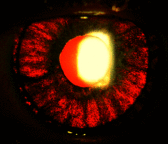Bilateral acute iris transillumination (BAIT) syndrome: literature review
- PMID: 31239635
- PMCID: PMC6556534
- DOI: 10.2147/OPTH.S167449
Bilateral acute iris transillumination (BAIT) syndrome: literature review
Abstract
The authors conducted a literature review about bilateral acute iris transillumination (BAIT) syndrome, a new and relatively unknown syndrome that should be described and made known to the greatest number to avoid potential diagnostic and therapeutic errors. The first cases date back only to 2004 and a total of 79 cases have been published to date, mainly in Europe and especially in Turkey and Belgium. It mainly affects young women between the ages of 30 and 50, and symptoms are often preceded by an upper airway infection. There is also a majority of cases where the onset of the syndrome follows oral intake of moxyfloxacin. The clinical signs are dominated by strong photophobia, secondary to a spectacular transillumination of the iris. Other classical symptoms are conjunctival infection, eye pain, blurred vision, temporary ocular hypertonia, fixed mid-dilated pupils, and pigment dispersion in the anterior chamber with pigmentary deposits in the trabecular meshwork in gonioscopy, symptoms that may be mistaken for uveitis. After a few weeks or months of evolution, persistent sequelae were pupillary atony and chronic and bilateral transillumination of the iris, leading to significant photophobia and sometimes persistent ocular hypertension. The BAIT syndrome is close to the bilateral acute depigmentation of the iris (BADI) syndrome, which is similar to BAIT but lacks associated transillumination. A few cases of patients with BAIT syndrome on one eye and BADI syndrome on the contralateral eye have been described, which confirms some form of link between the two clinical entities.
Keywords: BADI syndrome; BAIT syndrome; iris transillumination; moxifloxacin; photophobia; trabeculum pigmentary deposit.
Conflict of interest statement
The authors report no conflicts of interest in this work.
Figures



References
-
- Bringas Calvo R, Iglesias Cortiñas D. [Acute and bilateral uveitis secondary to moxifloxacin]. Arch Soc Esp Oftalmol. 2004;79(7):357–359. - PubMed
Publication types
LinkOut - more resources
Full Text Sources

